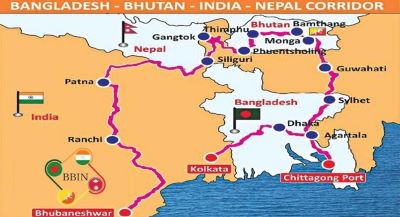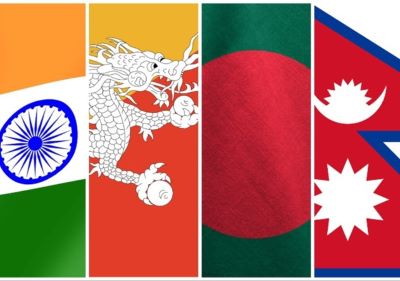Context-
Enhancing regional integration in South Asia is crucial for India as it continues to rise as a global power. A key tenet of this rise is maintaining a stable neighbourhood. Integrating the region through the Bangladesh-Bhutan-India-Nepal (BBIN) Corridor is central to this goal, reflecting the Indian government's commitment to connectivity and cooperation with its neighbors.
As the National Democratic Alliance (NDA) government enters its third term, it brings with it a decade of continuity in foreign policy, driven by initiatives like Neighbourhood First, Act East, and Act West. These policies aim to bolster digital, transport, and trade connectivity, enhancing people-to-people ties with neighboring countries. The Neighbourhood First initiative focuses on cooperation within South Asia and extends to the Middle East, aiming to create robust links in various sectors.
Evolution of Regional Integration
Over the past decade, India has increasingly focused on enhancing transport connectivity and facilitating cross-border energy trade in South Asia. The BBIN multimodal corridor stands as a pivotal project in this strategy. This corridor aims to enhance trade, cross-border movement, and people-to-people ties, linking landlocked Nepal and Bhutan to ports in India and Bangladesh, while also developing interconnected energy grids for regional energy security.
The BBIN’s Geopolitical Rationale
● Historical Context
For years, regional cooperation within South Asia was hindered by the tense relationship between India and Pakistan, which affected the functionality of the South Asian Association for Regional Cooperation (SAARC). This dynamic changed in 2014 when the NDA government signalled a willingness to improve relations with Pakistan. However, at the 18th SAARC summit in Nepal in 2014, Pakistan’s objections stalled a Motor Vehicle Agreement aimed at enhancing connectivity. This led to a sub-regional approach, with Bhutan, Bangladesh, India, and Nepal signing a separate Motor Vehicle Agreement in 2015. This was a turning point, marking India’s efforts to leverage sub-regional connectivity to foster broader regional cooperation.

● Strategic Shifts
India’s strategic focus has shifted from preoccupation with Pakistan to addressing the growing Chinese presence in the region. China’s Belt and Road Initiative (BRI) has significantly increased its influence through infrastructure investments and political cooperation, posing a challenge to India. The BBIN corridor is part of India’s strategic response to this challenge, aiming to enhance ties with its neighbors and counterbalance China’s influence.
● India as a Regional Conduit
A notable example of India’s role as a regional conduit is the power trade deal between Nepal and Bangladesh, where Nepal exports 40 megawatts of power to Bangladesh through the Indian power grid. This demonstrates India’s capability to act as a bridge between its neighbours, fostering cooperation and regional stability. Sub-regional initiatives like the BBIN corridor are expected to create positive externalities, laying the groundwork for long-term regional cooperation.
Contours and Chasms of the BBIN’s Transport Sector
Transport connectivity is vital for regional integration and intra-regional trade. South Asia has faced significant gaps in transport infrastructure due to political ill-will and fragile regional security. To address this, India has undertaken several cross-border transport projects aimed at enhancing trade, commerce, and people-to-people ties.
Key Projects
1. Bangladesh:
○ India has built and financed five railway links connecting various regions of Bangladesh to India through West Bengal.
○ These projects include connecting the Mongla Port in Bangladesh to India, enhancing regional transport infrastructure.
2. Bhutan:
○ India is building two railway corridors (Kokrajhar-Gelupu and Banarsat-Jhambe) to connect Bhutan to India and further to the Mongla Port in Bangladesh.
○ This involves linking Bangladesh’s Khulna rail terminal with the Mongla port and further integrating it into the Indian rail network.
3. Nepal:
○ India is constructing a 171-kilometre-long Kathmandu-Raxaul railway line, which will connect to the existing India-Nepal railway network.
Challenges and Solutions
While significant progress has been made in rail connectivity, other aspects of the corridor need attention. The BBIN Motor Vehicle Agreement (MVA), aimed at regulating passenger and cargo vehicular traffic, has faced delays. Despite initial ratification by Nepal, India, and Bangladesh in 2022, Bhutan did not sign due to environmental concerns and lack of infrastructure. However, in March 2024, Bhutan expressed willingness to address these gaps.
For the BBIN corridor to reach its full potential, several measures are necessary:
● Holistic Policy Implementation: Swift and coordinated policy action is required to complement rail connectivity.
● Free Trade Agreements (FTAs): Effective FTAs are essential for removing barriers and boosting intra-regional trade. The existing South Asia Free Trade Area (SAFTA) has been ineffective due to political issues and complex tariff structures.
● Road Infrastructure: There is a need for significant improvements in road transport infrastructure, reducing detours and enhancing efficiency at border check-posts.
Conclusion
India’s development of the BBIN corridor is both strategic and economic. Enhancing regional integration supports India’s rise as a global power and ensures a stable neighborhood, crucial for its territorial integrity, especially in contested regions like Arunachal Pradesh. The BBIN corridor promises significant infrastructure development for partner countries, aligning their growth with India’s trajectory. To successfully counter China’s influence and execute large-scale projects, India must also focus on multifaceted development across sectors such as finance, energy, digitization, and social development. Maintaining momentum for regional connectivity in South Asia is essential for achieving these goals.
|
Probable Questions for UPSC Mains Exam- 1. What strategic and economic objectives does India aim to achieve through the development of the BBIN Corridor, and how does this initiative align with India's broader foreign policy goals such as the Neighbourhood First, Act East, and Act West policies? (10 Marks, 150 Words) 2. What are the key challenges faced in the implementation of the BBIN Corridor, particularly in terms of transport connectivity and policy agreements, and what measures can be taken to address these challenges to realise the full potential of the corridor? ( 15 Marks, 250 Words) |
Source- ORF







